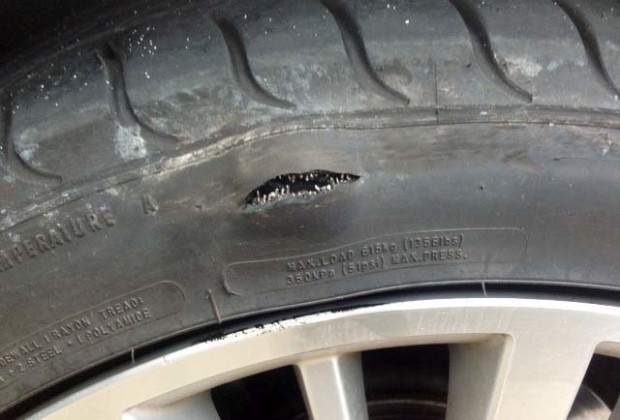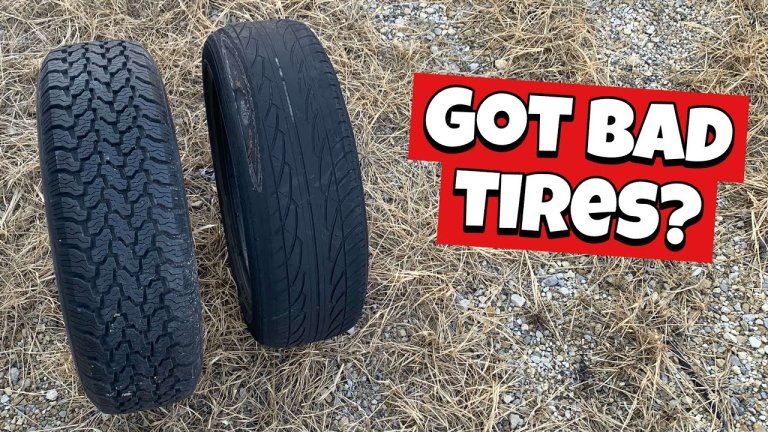Signs of tire failure include bulges, cracks, or excessive tread wear. Driving with worn tires increases the risk of accidents.
Ensuring your vehicle’s tires are in good condition is vital for safe driving. Recognizing the early signs of tire failure can help prevent roadside emergencies and maintain optimal vehicle performance. Bulges on the tire indicate internal damage, often caused by hitting potholes or road debris.
Cracks in the sidewall or tread area may signal dry rot due to age or exposure to harsh elements. Excessive tread wear compromises grip, especially on wet roads, putting you at greater risk for losing control. Regular inspections and maintaining proper tire pressure are key steps in avoiding tire failure and ensuring a smooth, safe journey.
Early Warning Signs Of Tire Trouble
Keeping a keen eye on your tires is crucial for a safe drive. Tires are your vehicle’s only contact with the road. Identifying the early signs of tire failure can prevent accidents.
Bulges And Blisters On The Tire Surface
Spotting a bulge or blister on your tire’s surface is a red flag. These often signal that the tire’s internal frame is damaged and can lead to a blowout.
- Inspect your tires regularly for these abnormal protrusions.
- A blistered or bulged tire needs immediate attention.
Tire replacement is essential if you see these signs.
Excessive Vibration Or Wobbling
Feeling an unusual amount of vibration or wobbling in your steering wheel is a warning. Vibration beyond the normal can be due to:
- Uneven tire wear.
- Wheel misalignment.
- Internal tire damage.
Don’t ignore persistent or worsening shake. Consult a professional to diagnose the issue. A quick response can prevent further damage.

Credit: mikeduman.com
Tire Tread Wear Patterns And Their Meanings
Understanding tire tread wear patterns is crucial for safe driving. Tread wear can tell a story about a tire’s condition. Recognizing these patterns early helps prevent tire failure. Let’s explore what certain tread wear signs mean about your tire’s health.
Center Wear: Overinflation Issues
Center wear indicates the middle part of the tire wears down faster than the edges. This condition often hints at overinflation. When tires have too much air, they bulge out. This bulging increases pressure in the tire’s center. As a result, the middle tread bears most of the road friction. Left unchecked, it could lead to potential blowouts. Checking tire pressure regularly maintains optimal inflation and even wear.
Edge Wear: Underinflation Problems
Edge wear is the opposite scenario. It features more pronounced wear on the outer edges. This pattern is a classic sign of underinflation. With insufficient air pressure, a tire’s sidewalls sink in. The tire’s edges then handle much of the vehicle’s weight. Edge wear reduces the tire’s grip on the road. It can also make the driving experience less stable. Keeping tires properly inflated ensures uniform wear and extends tire life.
Regular tire inspection is key to avoiding tire failure. Check for unusual tread wear during routine maintenance. This helps identify and correct inflation issues early. Below is a simple guide to understanding overinflation and underinflation patterns:
| Tread Wear Pattern | Possible Cause | Action Required |
|---|---|---|
| Center Wear | Overinflation | Reduce pressure to manufacturer’s specification |
| Edge Wear | Underinflation | Increase pressure to manufacturer’s specification |
Sudden Air Pressure Loss Indicators
Drivers must remain vigilant about sudden air pressure loss indicators in tires. Uneven handling or a wobbly feeling in the steering wheel often means trouble. Recognizing the signs can prevent accidents and costly repairs. Let’s explore these indicators in more detail.
Rapid Deflation: Causes And Responses
Rapid deflation can turn a normal drive into a roadside emergency. Causes of rapid deflation include:
- Puncture from nails or debris
- Valve stem damage from wear or corrosion
- Tire bead leaks where the tire meets the rim
Respond to rapid deflation by:
- Keeping a firm grip on the steering wheel
- Pulling over safely
- Using hazard lights to alert others
- Changing to the spare tire or seeking professional help
Pressure Monitoring Systems Alerts
Many vehicles now come with Pressure Monitoring Systems (TPMS). The TPMS warning light illuminates when:
| TPMS Light | Action Required |
|---|---|
| Steady illumination | Check and adjust tire pressures |
| Flashing light | TPMS may have a malfunction. Seek service immediately. |
Boldly addressing alerts from your TPMS can spare you from unexpected tire failure. Remember, tire care is crucial for road safety.

Credit: www.cdljobs.com
Visible Damage And Its Implications
Tires are your car’s sole contact with the road. Visible damage on tires can signal danger. Regular checks keep you safe. Let’s explore common signs.
Cuts, Cracks, And Punctures
Tire walls should be smooth and unbroken. When cuts, cracks, or punctures appear, act promptly.
- Cuts: Long, sharp slices may expose internal layers.
- Cracks: Weathered rubber can develop cracks, risking blowouts.
- Punctures: Sharp objects cause holes, leading to slow leaks or sudden air loss.
Impact Of Foreign Objects On Tire Integrity
Nails, screws, and debris can embed in tire treads. These foreign objects weaken tire strength. They pose blowout risks. Check tires often for rogue items.
Visible bulges or blisters spell trouble. Tires with these should not be used. They can lead to serious car accidents. Visit a professional for tire assessments and repairs.
| Damage Type | Sign | Risk | Action |
|---|---|---|---|
| Cuts | Slices on tire surface | Internal layers exposure | Professional inspection |
| Cracks | Lines or grooves on tire | Risk of blowouts | Replace tire |
| Punctures | Holes in tire | Loss of air pressure | Patch or replace |
Abnormal Tire Noises And What They Signal
Listening closely to the sounds your tires make can tell you a lot about their health. Unusual noises often serve as early warnings for tire failure.
Squealing During Turns
When tires squeal during sharp turns or at high speeds, this could indicate low tread depth or under-inflation. Ensure proper inflation and inspect for uneven wear patterns.
Thumping Sounds While Driving
A rhythmic thumping noise while the car is in motion could be a sign of imbalance or internal damage. It’s crucial to have tires checked as they may pose a safety risk.
Consistent inspection and swift action when noticing abnormal noises can extend tire life and ensure road safety.

Credit: blog.mccarthytoyotaofsedalia.com
The Influence Of Aging On Tires
The Influence of Aging on Tires is undeniable. As tires age, their components start to deteriorate, even if the tread appears to have life left. Rubber loses its elasticity over time and becomes brittle, leading to reduced performance and potentially dangerous situations. Recognizing the signs of tire failure due to aging can mean the difference between a safe journey and a risky roadside situation.
Dry Rot: Indications And Dangers
Dry rot is a common issue with aging tires. This condition, indicated by cracks in the sidewall and discoloration, compromises the tire’s integrity. Here are some clear signs and potential hazards:
- Cracks on the Surface: Small web-like patterns on the tire surface indicate dry rot.
- Faded Color: Tires turning from black to a dull gray may suggest dry rot.
- Air Pressure Loss: Aging tires lose pressure faster, risking a blowout.
Dry rot not only affects the tire’s looks but also poses real dangers such as reduced traction, tire failure, and blowouts.
Tire Shelf Life And Replacement Criteria
Many aren’t aware that tires have a “best by” date. With age, the risk of failure increases. To ensure safety, know the criteria for tire replacement:
| Criteria | Replacement Indicator |
|---|---|
| Tread Depth | 1/16th inch or less |
| Age of Tire | 5-6 years, regardless of appearance |
| Visible Damage | Cuts, bulges, or punctures |
| Ride Comfort | Increased vibration or roughness |
Keep in mind these key replacement indicators to prevent tire-related accidents. Replace tires as soon as they meet any of these conditions.
Sidewall Irregularities
Tire sidewalls should have a smooth appearance. Sidewall irregularities can signal tire failure. Such defects might not seem urgent. Yet, small issues can lead to bigger problems.
Sidewall Indentations: Cause For Concern
Indentations on tire sidewalls need attention. These are signs your tire strength is compromised.
- Visible grooves or cuts
- Unnatural sinking areas
Manufacturing flaws or hitting potholes can cause indentations. Regular checks help spot them early.
Sidewall Protrusions And Their Risk
A bulge or protrusion on a tire’s sidewall is serious. This could mean internal damage.
- Impact from curbs can lead to bulges
- Driving on a flat tire increases risks
Internal pressure pushes outwards, forming a bubble. This weakens the tire structure. If ignored, a blowout could occur.
Tire Performance In Wet Conditions
Understanding tire performance in wet conditions is crucial for safe driving. Tires grip the road to keep your vehicle stable. But when they fail, the risk on wet roads spikes. Identifying signs of tire failure early can save lives.
Hydroplaning: An Early Sign Of Wear
Hydroplaning happens when tires cannot scatter water on wet roads. You might feel the steering become light or unresponsive. This is a sign of worn tire tread. Proper tread depth helps disperse water and maintain control. If hydroplaning occurs frequently, it’s time for a tire check.
Wet Traction Reduction As Failure Warning
In wet conditions, good tires are key. Reduced wet traction is a sign your tires might be failing. Notice any slipping or longer stopping distances? These point towards a loss of grip. Bald tires can’t maintain a solid contact on wet roads. It’s a clear call for inspection.
- Bald Spots: Look for smooth areas on tires.
- Tread Wear Bars: See if these flat rubber bars are flush with the tire’s tread.
- Sidewall Cracks: Cracks in the tire sidewall can lead to failure too.
Conclusion
Recognizing the signs of tire failure is crucial for your safety on the road. Regular inspections can avert potential hazards and keep your vehicle running smoothly. Don’t ignore the warning signs; proactive maintenance can prevent accidents and save lives. Ensure your tires are always in top shape and enjoy peace of mind behind the wheel.




